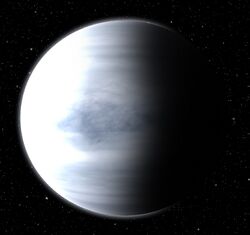Astronomy:Kepler-443b
From HandWiki
Short description: Extrasolar planet
 | |
| Discovery | |
|---|---|
| Discovered by | Guillermo Torres et al.[1] |
| Discovery site | Kepler |
| Discovery date | January 7, 2015 |
| Transit method | |
| Orbital characteristics | |
| 0.495 AU (74,100,000 km)[1] | |
| Eccentricity | ≥0.11[1] |
| Orbital period | 177.6693[1] d |
| Inclination | 89.94[1] |
| astron|astron|helion}} | JD 2455630.2460[1] |
| Star | Kepler-443 |
| Physical characteristics | |
| Mean radius | 2.33[1] R⊕ |
Kepler-443b is an exoplanet about 2,540 light-years from Earth.[2] It has an 89.9 percent chance of being in the star's habitable zone, yet only a 4.9 percent chance of being rocky.[1]
Characteristics
Mass, radius and temperature
Kepler-443b has a mass of 6.04 Earth masses,[3] a radius of 2.33 Earth radii[2] and a temperature of 247 kelvin.[2]
Host star
Kepler-443b orbits a K-type star called Kepler-443, 2541 light-years away.[2]
Orbit
Kepler-443b takes 177.6693 days to orbit its star, with an inclination of 89.94°, a semimajor axis of 0.495 AU and an eccentricity of at least 0.11.[2]
Habitability
Kepler-443b may be habitable, but the planet has only a 4.9 percent chance of being rocky.[1] The planet is much more likely to be a water world or a Mini-Neptune.
References
- ↑ 1.0 1.1 1.2 1.3 1.4 1.5 1.6 1.7 1.8 Torres, Guillermo; Kipping, David M.; Fressin, Francois; Caldwell, Douglas A.; Twicken, Joseph D.; Ballard, Sarah; Batalha, Natalie M.; Bryson, Stephen T. et al. (2015). "Validation of 12 Smallkeplertransiting Planets in the Habitable Zone". The Astrophysical Journal 800 (2): 99. doi:10.1088/0004-637X/800/2/99. Bibcode: 2015ApJ...800...99T.
- ↑ 2.0 2.1 2.2 2.3 2.4 "HEC: Data of Potentially Habitable Worlds". Planetary Habitability Laboratory. 15 November 2017. http://phl.upr.edu/projects/habitable-exoplanets-catalog/data. Retrieved 17 April 2018.
- ↑ "Eyes on Exoplanets-Kepler-443b". https://exoplanets.nasa.gov/eyes-on-exoplanets/#/planet/Kepler-443_b/.
 |

